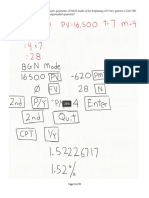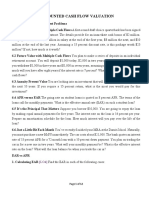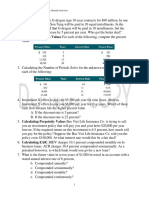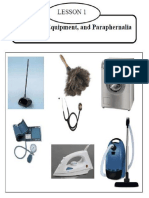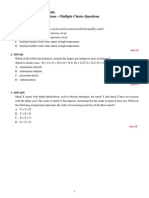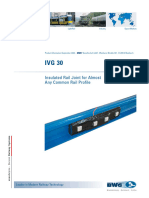Topic 3 Practice Questions
Uploaded by
tijopaulose00Topic 3 Practice Questions
Uploaded by
tijopaulose00CORPFIN 7005 - Principles of Finance (M)
Topic 3: Discounted cash flows and valuation
1. How do an ordinary annuity, an annuity due and a perpetuity differ?
2. What is the APR, and why are lending institutions required to disclose this rate?
3. Future value with multiple cash flows: You are first year at university and are planning a
trip to Canada when you graduate at the end of 4 years. You plan to save the following
amounts annually, starting today: $781, $627, $895 and $920. If the account pays 6.03
per cent annually, how much will you have at the end of 4 years?
4. Present value of an ordinary annuity: An investment opportunity requires a payment of
$592 for 12 years, starting a year from today. If your required rate of return is 8.8 per
cent, what is the value of the investment today?
5. Future value of an ordinary annuity: Silas Yeung is a sales executive at a Brisbane
company. She is 25 years old and plans to invest $2296 every year in a retirement savings
account, beginning at the end of this year until she turns 65 years old. If the retirement
savings investment will earn 11.31 per cent annually, how much will she have in 40 years
when she turns 65 years old?
6. Calculating annuity payment: The Bridge Bar & Grill has a 7-year loan of $23 500 with
Bankwest. It plans to repay the loan in 7 equal instalments starting today. If the rate of
interest is 8.4 per cent per annum, how much will each payment be worth?
7. Effective annual rate: Rajesh Sachdeva bought a Honda Civic for a price of $17 345. He
deposited $6000 and financed the rest through the dealer at an APR of 9.3 per cent for 4
years. What is the effective annual rate (EAR) if payments are made monthly?
Chee Cheong & Ratna Derina 1
CORPFIN 7005 - Principles of Finance (M)
8. Present value with multiple cash flows: Polly Chan, a lottery winner, will receive the
following payments over the next 7 years. If she can invest her cash flows in a fund that
will earn 10.5 per cent annually, what is the present value of her winnings?
9. Effective annual rate: Which of the following investments has the highest effective annual
rate (EAR)?
a. A bank term deposit that pays 8.25 per cent compounded quarterly.
b. A bank term deposit that pays 8.25 per cent compounded monthly.
c. A bank term deposit that pays 8.45 per cent compounded annually.
d. A bank term deposit that pays 8.25 per cent compounded semiannually.
e. A bank term deposit that pays 8 per cent compounded daily (on a 365-day basis).
10. You have saved $4000 for a down payment on a new car. The largest monthly payment
you can afford is $350. The loan would have a 12 percent nominal rate based on end-of-
month payments. What is the most expensive car you could afford if you finance it for 48
months? For 60 months?
Chee Cheong & Ratna Derina 2
You might also like
- CFA Level 1 Calculation Workbook: 300 Calculations to Prepare for the CFA Level 1 Exam (2024 Edition)From EverandCFA Level 1 Calculation Workbook: 300 Calculations to Prepare for the CFA Level 1 Exam (2024 Edition)4.5/5 (6)
- CFP Certification Exam Practice Question Workbook: 1,000 Comprehensive Practice Questions (2019 Edition)From EverandCFP Certification Exam Practice Question Workbook: 1,000 Comprehensive Practice Questions (2019 Edition)5/5 (1)
- CFP Exam Calculation Workbook: 400+ Calculations to Prepare for the CFP Exam (2019 Edition)From EverandCFP Exam Calculation Workbook: 400+ Calculations to Prepare for the CFP Exam (2019 Edition)5/5 (1)
- Practice Problem Set #1: Time Value of Money I Theoretical and Conceptual Questions: (See Notes or Textbook For Solutions)No ratings yetPractice Problem Set #1: Time Value of Money I Theoretical and Conceptual Questions: (See Notes or Textbook For Solutions)15 pages
- Assignemt - Chapter 2 - Time Value of MoneyNo ratings yetAssignemt - Chapter 2 - Time Value of Money3 pages
- Concept Questions: Compound Interest: Future Value and Present ValueNo ratings yetConcept Questions: Compound Interest: Future Value and Present Value4 pages
- Chapter 3 - Concept Questions and ExercisesNo ratings yetChapter 3 - Concept Questions and Exercises3 pages
- Chapter 3 - Concept Questions and ExercisesNo ratings yetChapter 3 - Concept Questions and Exercises3 pages
- Solutions Lecture Practice Questions DCFNo ratings yetSolutions Lecture Practice Questions DCF6 pages
- CHAPTER 3.1e - Time Value of Money-Exercises - sv4.0No ratings yetCHAPTER 3.1e - Time Value of Money-Exercises - sv4.02 pages
- 2 0405 Discounted Cash Flow Valuation and Investment Appraisals.No ratings yet2 0405 Discounted Cash Flow Valuation and Investment Appraisals.9 pages
- FINC 655 Summer 2012 Exam #1 - You Must Show All of Your Work To Receive Any Credit Problems (5pts Each)No ratings yetFINC 655 Summer 2012 Exam #1 - You Must Show All of Your Work To Receive Any Credit Problems (5pts Each)7 pages
- Chapter 3 - Concept Questions and ExercisesNo ratings yetChapter 3 - Concept Questions and Exercises3 pages
- Applications of Thin Airfoil Theory - Part 1No ratings yetApplications of Thin Airfoil Theory - Part 128 pages
- AWS Solutions Architect Associate Study PlanNo ratings yetAWS Solutions Architect Associate Study Plan5 pages
- Joining The Ties of Kinship - Islamic NetworkNo ratings yetJoining The Ties of Kinship - Islamic Network4 pages
- Western Civilization 9th Edition Jackson J. Spielvogel - Read the ebook online or download it as you prefer100% (1)Western Civilization 9th Edition Jackson J. Spielvogel - Read the ebook online or download it as you prefer52 pages
- Manual - Aquastar 54 - Aquastar 54 LED PDFNo ratings yetManual - Aquastar 54 - Aquastar 54 LED PDF80 pages
- Jurnal Pengaruh Pemberian MPASI Fortifikasi Vs HomemadeNo ratings yetJurnal Pengaruh Pemberian MPASI Fortifikasi Vs Homemade5 pages


